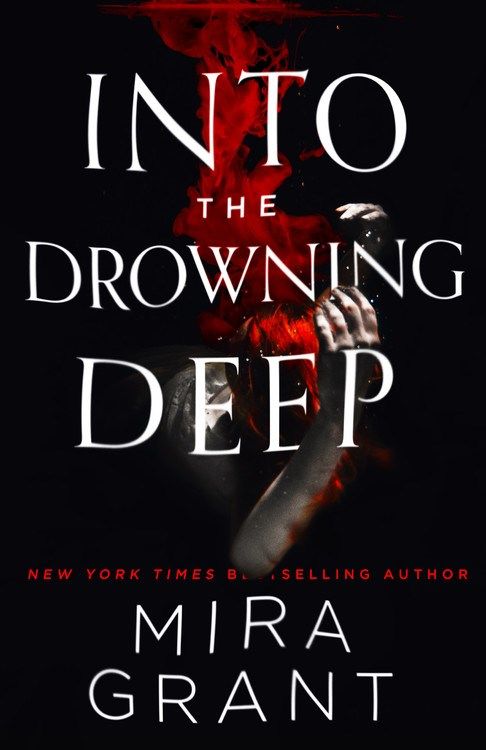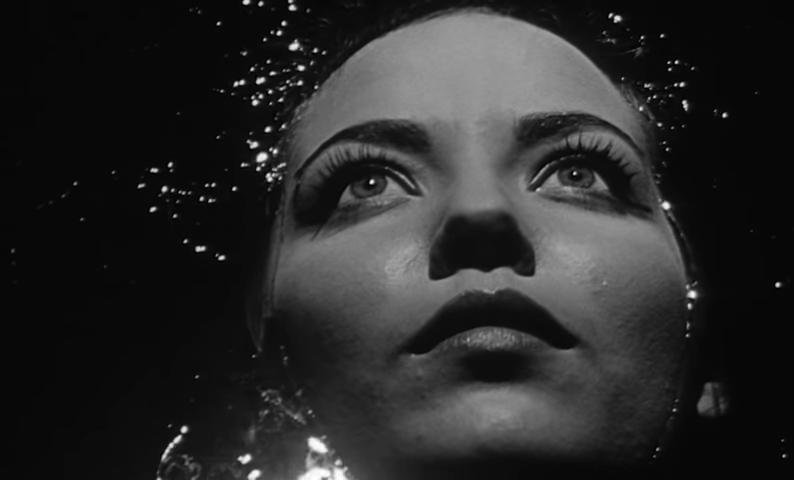
Into the Drowning Deep: Be Afraid of the Ocean
Personally, I’ve always thought that mermaids are a criminally underrated monster in horror. The original story of sirens involved them using beauty to lure unsuspecting sailors to their deaths. Have you ever read the Odyssey, where they literally have to plug their ears so that they don’t wreck the ship and get murdered? That’s hardcore. Into the Drowning Deep by Mira Grant is a 2017 horror novel based on the evil within the mermaid myth, and it will keep you on the edge of your seat the whole time.

What’s it about?
Years ago, a ship called the Atargatis set out towards the Marianas Trench with the goal of finding scientific evidence of mermaids. Because the journey was funded by media conglomerate Imagine, the entire voyage was recorded (in hopes of making a documentary). Unfortunately, instead of a fun documentary about cryptids, what the company actually got was a video of their entire crew being slaughtered, leaving an empty vessel in the middle of the ocean. Seven years later, Tori, the sister of one of the disappeared crew members, is contacted by Imagine. They’re sending out another ship, this time to determine what exactly happened to the Atargatis. She accepts, as a way of avenging her lost relative. What she discovers during the voyage will haunt her forever.
Killer Mermaids? Really?
Yes, really. The mermaids in this book are not the Ariel-style ones you might be picturing. Grant takes a much more scientific approach to them, designing them as true creatures of the deep. Have you seen deep-sea fish? They’re horrifying.
Aside from their hideous appearances, the mermaids also behave like animals. These creatures aren’t “monsters” in the traditional way, with complex motivations or a genuine love of terrorizing people. The mermaids in Into the Drowning Deep are just animals. They’re motivated by wanting to eat and survive life in the ocean. To me, the fact that they have no morals and are literally just motivated to kill by their survival instinct made them way more terrifying. That, combined with their physicality being like other deep-sea creatures, the claustrophobia of being alone on a ship in the middle of the ocean, and the looming dread of what happened to the Atargatis, made the horror in this book really work well for me.
What about the humans?
Well, this is a Mira Grant (also known as Seanan Mcguire) book, so the characters are also compelling and genuine. One of the things I really loved about this book is its truly diverse ensemble cast. Into the Drowning Deep had an autistic character, a Deaf character, a physically disabled character, multiple different sexual orientations, and multiple different races. It was awesome! The diversity added to the story for me. Just as interesting as seeing what would happen with the mermaids was seeing what would happen when all of these different people were put into an enclosed space together.

Obviously, as someone who doesn’t have all these identities, I can’t accurately tell you how well all of them were treated. But, I will say as someone with hearing issues that the representation of Deaf culture was amazing. Not only did the characters use sign language to communicate with each other (and explain the difference between the several different forms of sign language in use in America), they also used it to communicate with the mermaids. That is really cool to see. I encourage you to read it if you’re interested in reading more Deaf characters.
Final Thoughts
The only thing I didn’t like about this book was the ending. This is a spoiler-free review, so I won’t say anything about the plot, but I thought the ending wrapped things up a little too nicely. I would have liked to see a little more struggle and maybe less success. That’s why I took off a half star in my rating.

Overall, though, I totally loved this book. From beginning to end, it was compelling, terrifying, and unique. I hope the author continues writing books in this world, because I honestly can’t get enough of these killer mermaids.
 (4.5 / 5)
(4.5 / 5)
Book Reviews
A Stellar Debut Novel, We Used To Live Here
Imagine this. You’re home alone, waiting for your partner to return, when you hear a knock on your door. You answer it to see a family of five, bundled up against the cold. The father, a kindly older gentleman, explains that he used to live in this house as a boy. And he would love to show it to his family.
Do not let them in.
The story
Released in June 2024, We Used To Live Here is author Marcus Kliewer’s debut novel. It tells the story of Eve, who just purchased a beautiful house with her partner, Charlie. Their plan is to flip the house and sell it.
One night, while waiting for Charlie to come home, Eve is surprised by a knock at the door. It’s a man named Thomas Faust and his family.
Thomas explains that he grew up in the house and hasn’t been in the area in years. Would Eve let them in so that he can show the home to his children?
Against her better judgment, Eve lets them in. She regrets this almost at once when Thomas’s daughter vanishes somewhere into the house.
What worked
I always appreciate a book that allows you to play along with the mystery. And this book does that better than just about any other I’ve seen.
Pay close attention to the chapters, to the words that aren’t there. To everything about this novel.
This is mostly down to Kliewer. This is ultimately his work of art. But the production value is also fantastic. I don’t want to ruin the multiple mysteries, so I’ll just say this. There are clues in this book that require some specific artistic choices in the page layouts in this book. And I loved that.
If you’d like to experience another horror book review, check out this one.
We Used To Live Here is also the kind of story that makes you question everything right along with the main character, Eve. Eve is a great main character. But she might be an unreliable narrator. She might be experiencing every single horror described, exactly as it’s described. Or, she might be having a psychotic breakdown. Through most of the book, we can’t be sure. And that is so much fun.
Finally, the weather plays a large part in this story. There are several stories in which the weather or the land itself could be considered a character. Even an antagonist. This is certainly one. The winter storm is the thing that traps the family in the house with Eve. It also makes escaping the home difficult. Reading this book during the winter was especially impactful. Most of us know what it feels like to be shut in by a storm. I’ve personally lived through some of those storms that are just referred to by their year, as though they were impactful enough to claim the whole 365 days for themself. And that was with people I liked. Imagine what it would feel like with strangers. It’s a staggering thought and one that we explore in depth in this book.
- Get Out meets Parasite in this eerily haunting debut and Reddit hit—soon to be a Netflix original movie starring Blake Lively—about two homeowners whose lives are turned upside down when the house’s previous residents unexpectedly visit
- As a young, queer couple who flip houses, Charlie and Eve can’t believe the killer deal they’ve just gotten on an old house in a picturesque neighborhood
- As they’re working in the house one day, there’s a knock on the door
Last update on 2025-03-08 / Affiliate links / Images from Amazon Product Advertising API
In the end, We Used To Live Here is a fantastic book. It’s the sort of story that sneaks into your brain and puts down roots. And if this is just the first book we’re getting from Kliewer, I can’t wait to see what else he comes up with.
 (5 / 5)
(5 / 5)
Book Reviews
Exploring real terror with The House of My Mother
As a disclaimer, this is a review of The House of My Mother from a critical perspective. I will not be discussing my opinions of the legal case against Ruby Franke and Jody Hildebrandt. I will be discussing the merits of the book as a work of true crime alone.
In 2015, Ruby Franke started a YouTube channel called 8 Passengers. In August of 2023, Franke and her business associate Jodi Hildebrandt were arrested for, and later plead guilty to, charges of aggravated child abuse. And in January of this year, Shari Franke told her story in The House of My Mother.
The story
The House of My Mother is the true story of Shari Franke, the oldest child of one of the most famous family vlogger families.
As a child, Shari came to the conclusion that her mother didn’t like her. Soon, she began to fear her mother’s anger.
Things got significantly worse when Ruby started their family vlog. All of the families most intimate moments were splashed across the internet for anyone to watch. This became a living nightmare for Shari.
Of course, that was only the start of the family nightmare. Because Ruby was about to meet someone who would reinforce all of the darkest parts of herself.
Eventually Shari manages to escape her home. But her younger siblings were still in her mother’s clutches. She had to save them, and her father, from the monster her mother had become.
What worked
Through the book, Shari only ever mentions the name of one of her siblings, Chad. This is because Chad is the only of her siblings that is an adult at the time of the publication.
There are children involved in this story. Children who’s lives and privacy have already been damaged. Shari didn’t want to do that to them again, and neither do I.
It probably won’t surprise you that this book is full of upsetting details. But not in the way you might imagine.
Nowhere in this book will you find gory details about the abuse the Franke kids suffered. And I consider that a good thing. Those sort of details are all fun and games when we’re talking fiction. When it’s real kids who are really living with the damage, it’s not a good time.
What you’ll find instead is a slew of more emotionally devastating moments. One that stuck with me is when Ruby’s mother gives her a pair of silk pajamas as a gift after Ruby gave birth to one of her babies. Shari asks Ruby if she’d bring her silk pajamas when she had a baby. Ruby responds that yes, when Shari becomes a mother they can be friends.
What a lovely way to make a little girl feel like she’s not worth anything unless she reproduces. And, if she does decide to have children, who is going to bring her silk pajamas?
- From eldest daughter Shari Franke, the shocking true story behind the viral 8 Passengers family vlog and the hidden abuse she suffered at the hands of her mother, and how, in the face of unimaginable pain, she found freedom and healing
- Shari Franke’s childhood was a constant battle for survival
- Her mother, Ruby Franke, enforced a severe moral code while maintaining a façade of a picture-perfect family for their wildly popular YouTube channel 8 Passengers, which documented the day-to-day life of raising six children for a staggering 2
Last update on 2025-03-02 / Affiliate links / Images from Amazon Product Advertising API
In the end, this isn’t a story about ghosts or demons. It’s not about a serial killer waiting on a playground or in the attic of an unsuspecting family. Instead, this is a story about things that really keep us up at night. It’s the story of a woman so obsessed with perfection that she drove away her eldest daughter. The story of a young woman who’s forced to watch from afar as her beloved brothers and sisters are terrorized and abandoned. These are the sorts of things that really keep us up at night. These are the real nightmares.
More than that, though, The House of My Mother is a story of survival. It’s about a family that was ripped apart and somehow managed to stitch itself back together again. It’s about a brave young woman who managed to keep herself safe and sane in the face of a nightmare. If you haven’t read it yet, I can’t recommend it enough.
For more like this, check out my review of Shiny Happy People.
 (5 / 5)
(5 / 5)
Book Reviews
Book Review of Boreal: an Anthology of Taiga Horror

Boreal: an Anthology of Taiga Horror is a collection of twenty-two haunting tales that dwell in the deepest darkest woods and frozen wastelands, edited by Katherine Silva and including Haunted MTL’s very own Daphne Fauber. Each story has even been gifted with its very own poster, hinting at the horrors to be found within it, bestowing a beautiful visual collection as well.
The tales are varied and touch upon the environment in new and different ways, each hearkening to a sort of epiphany or raised awareness. These stories exude both dread and wonder at the smallness of our human existence in contrast to the sacred world we have isolated from, sheltering ourselves in our comfortable houses with centralized heat and everything we could possibly need or want at the ready. The taiga becomes a sanctuary outside of our own dulled awarenesses. It is a holy place imbued with powers beyond mortal human reach, a wilderness that threatens to swallow us – both whole and bit by bit, simultaneously.
The protagonists enter into this realm through ritual, superstition, longing, stubbornness, and their own hubris – yearning to survive its dangers, and to make their own marks upon it. The starkness of their surroundings harbors delicate moments that would be all too easily missed if not deliberately sought or pointed out. The softness of fur, the dappled sunlight shining through trees, the hazy clouds of breath forming in crisp air, the brittleness of bleached bone… those quiet experiences that beg to be forgotten, to lay safely sleeping just below the frozen surface, awaiting spring.
There are those who followed in the footsteps of their predecessors, seeking to escape the constraints of their parent’s and elders’ indoctrination, traditions, madness, and abuse, yearning to find their own way despite also being inextricably bound to their own pasts. There are those who just wanted to go for a walk in the woods, and remained forever changed by what they experienced. There are those who wished to impose their will upon the wilderness, their order falling to disarray, unable to make lasting impact. There are those who sought to leave behind the world of mankind, looking for oneness in the natural order of things through isolation, leaving a bit of themselves behind after being consumed by the terrors they encountered. There are those who truly found communion with the woods, became one with its wildness, and invited its spirit into their hearts to find peace, even at cost of their own lives. And then, there are the spirits themselves…
 (3 / 5)
(3 / 5)
All in all, I give Boreal: an Anthology of Taiga Horror 3.0 Cthulhus. I love existential angst so I found it to be an enjoyable read, and I appreciated the myriad manners in which the biome was explored. But there were points in which I found myself struggling to follow along, as if the words were swept up into their own wilds in ways that alienated myself as reader, as if my mere voyeurism into this otherworldly place was not enough to comprehend the subtle deviations in storytelling mannerisms fully. I suppose in some sense this seems appropriate, but at the same time, it left me feeling a bit unfulfilled, as if I had missed a spiritual connection that should have resonated more deeply.
- English (Publication Language)
- 248 Pages – 02/25/2025 (Publication Date) – Strange Wilds Press (Publisher)
Last update on 2025-01-23 / Affiliate links / Images from Amazon Product Advertising API




VoodooPriestess
June 24, 2020 at 10:06 pm
Sounds like an interesting read! I’ll definitely check it out.